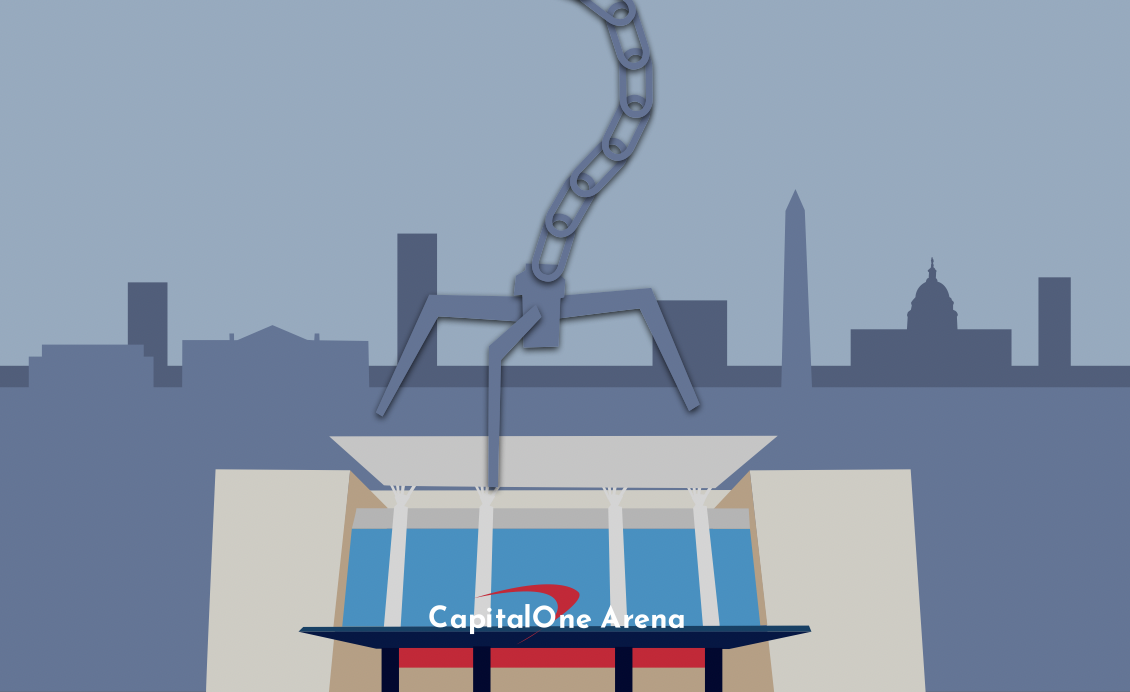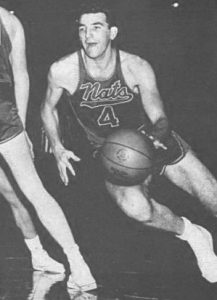“This is my fuckin’ town!” John Wall screamed while he stood on the announcers’ table after his Game 6 game-winner in the second round of the 2017 NBA Playoffs. Capital One Arena shook around him as 20,000 people reveled in the hysteria of a fleeting playoff moment. On that night, the Wizards star seemingly buried years of playoff heartbreak that had permeated Cap One, leaching into the psyches of every player and fan who walked those halls.
The Capitals had suffered years of heartbreak—true fans will remember the double whammy of home ice Game 7 losses in both the 2009 and 2010 seasons—and in their cup-winning season, they clinched every playoff series on the road. The Wizards spent most of their time in Capital One Arena lost in a morass of myopic trades and unfulfilled potential: Michael Jordan’s retirement tour, the Gilbert Arenas solo show, and then finally bottoming out in 2010 and drafting John Wall.
Cap One cheered louder than ever when Wall was introduced for his home debut, breaking out the Dougie as the sold-out arena welcomed their savior. And on that night in 2017, with the ball in his hands and the season on the line, Wall’s deep 3—unexpected that such a mediocre 3-point shooter made it, though less surprising that he took it—was a gift to a cynical crowd, keeping hopes alive for a road upset in Game 7. Jumping on the announcers’ table, Wall declared his love for the team, the fans, and the city of D.C. The crowd’s love for their star was measured in a cacophony of cheers that made the building shake. That 2017 team had been the high-water mark for the franchise since it changed its name in 1997, and Wall’s three-pointer marked the team’s apex. The Wizards lost that Game 7 in Boston, and Wall’s time in Washington was marked as much by his time in street clothes, dealing with major injuries, as it was by his Game 6 game-winner. Capital One Arena never got a chance to be that loud again. Now, it never will.
This past December, Monumental Sports—the organization run by Ted Leonsis that owns the Washington Capitals and Washington Wizards—announced their plans to move the teams to Virginia. By 2028, Capital One Arena will lose its major tenants, leaving the Georgetown Hoyas and maybe the Washington Mystics in limbo, most likely stuck in the abandoned arena and struggling more than ever to fill the seats. The Capitals and Wizards will be headed to the Potomac Yards in Alexandria—just six miles away, but with D.C. traffic, it might as well be 60. Of the four major sports teams that list Washington, D.C. as their home, only one will play within the city limits by the start of the next decade. Monumental Sports can call it a great business deal, but this matters not just in the world of business. It matters for the fans, who deserve more than what this deal will give them, and it matters for the city, whose already-struggling downtown is being dealt a near-fatal blow.
Sports are more than just the games being played. The memories, the connections, the fans, and the experiences are what make sports matter. Location matters, too. It’s the fact that Capital One Arena is easily accessible from nearly anywhere in the region. It’s seeing the trains fill up with red, white, and blue as the Metro gets closer and closer to the city center. It’s the chants that break out outside the arena as Chinatown buzzes with excitement—even if the team they’re watching doesn’t have a shot.
While these things are replicable in Alexandria, it’s just as likely that the Wizards’ mediocrity and a more difficult distance to traverse means fewer fans in the stands. It happened to the Commanders, who moved to Landover, Maryland in 1997. For years, they ranked in the top three in attendance just based on the sheer size of the stadium, but recently, the hallmark of FedEx Field is the lack of support, both in terms of empty seats and crumbling infrastructure throughout the stadium. As described in a Washington Post article about the Commanders’ falling attendance numbers, “things might not be so bad, some fans argued, if not for the location and condition of FedEx Field. The stadium in suburban Maryland, 24 years old and difficult to reach, contrasts with its previous, beloved home of RFK Stadium in Northeast Washington.” Sound familiar?
When Capital One Arena (originally called the MCI Center) opened in Chinatown back in 1997, the hope was that the arena would revitalize the area. It did just that, drawing thousands of fans to watch basketball, hockey, and concerts. As D.C. Councilmember Charles Allen noted last summer: “Capital One Arena is active year-round and sits on top of one of the most connected Metro stations in the country. It anchors two teams that play more than 80 home games a year, is home court for the Georgetown Hoyas and hosts concerts and special events, bringing more than 2 million people annually to the area for about 230 to 240 events a year.”
Now, like the old RFK stadium, Capital One Arena’s role as a community anchor will dissipate, leaving the surrounding area to suffer the consequences of such a move. Chinatown has, in recent years, struggled to keep its identity as gentrification and dilapidation have driven most of the Chinese population elsewhere. Without the pillar of a professional sports arena keeping businesses afloat, the neighborhood’s future looks even more dismal.
The move across the river isn’t just about the distance; having D.C. sports play in the heart of Washington, D.C. weaves the teams into the fabric of the city’s culture, making every game’s result a matter of civic pride. Without the pull of the beloved Cap One, fans might find themselves disengaged—and the teams might find themselves wishing they’d never left their true home after all.





